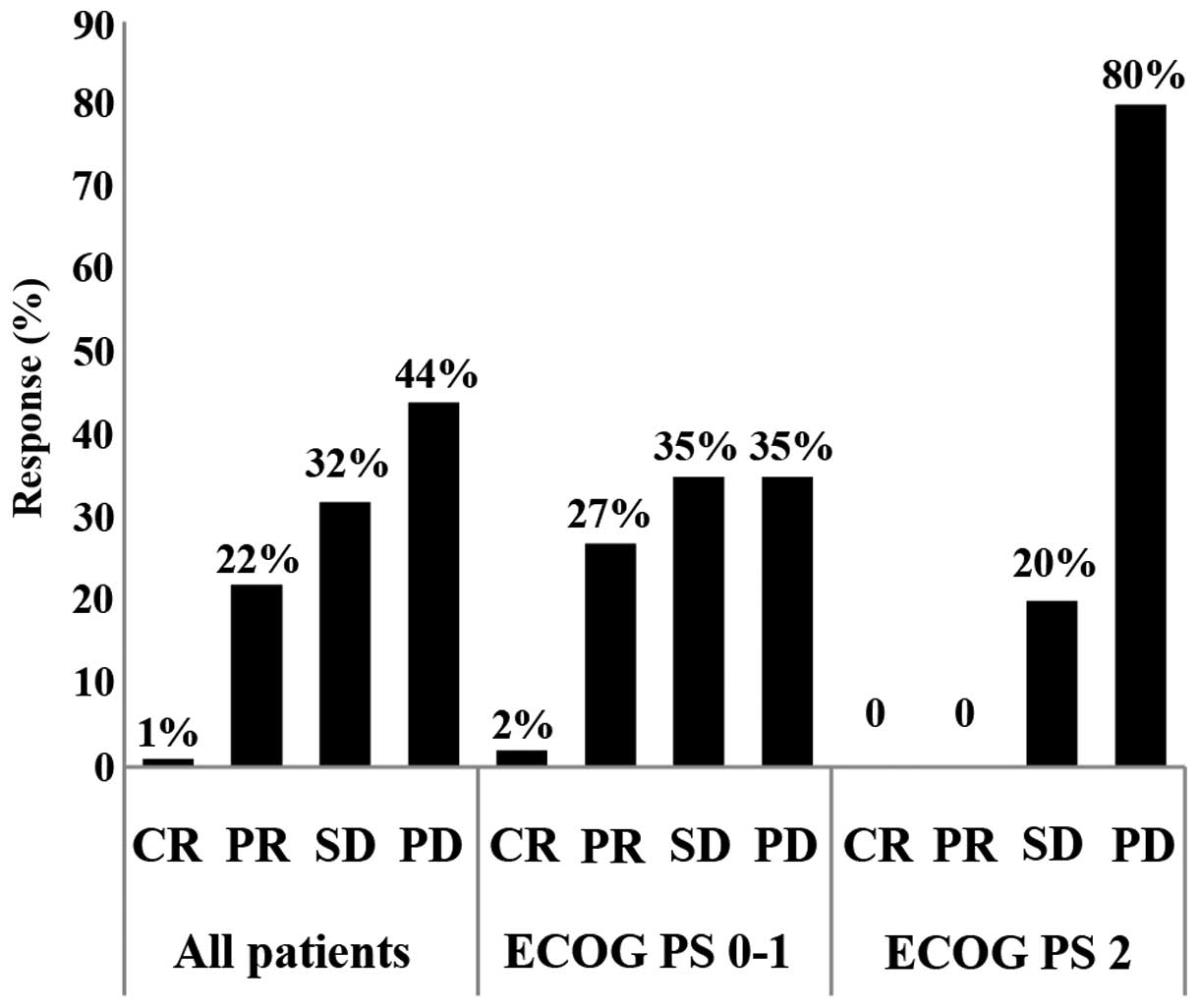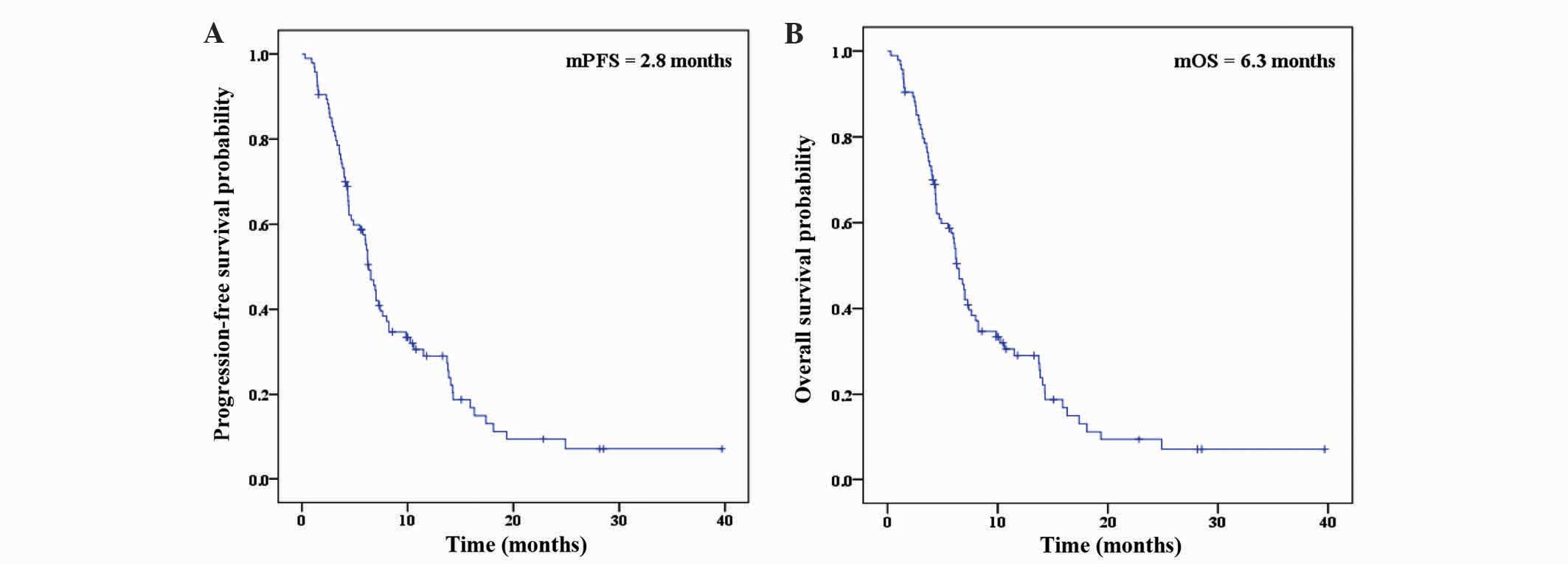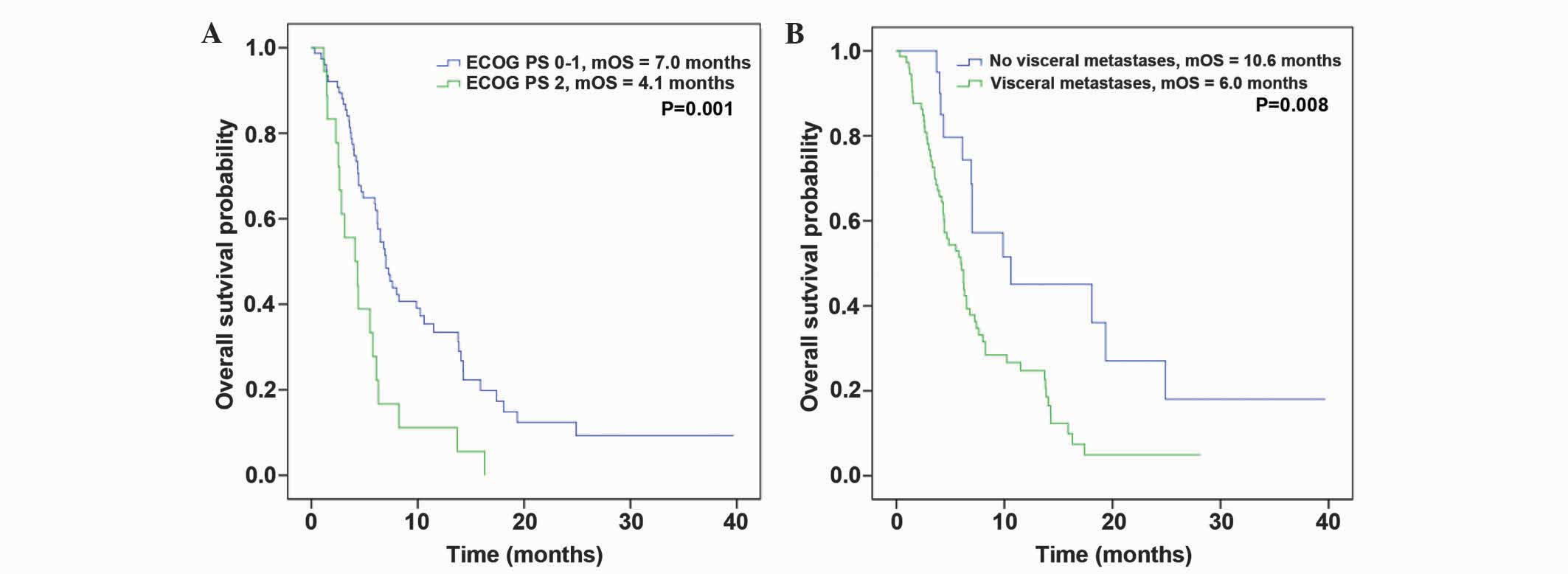|
1
|
von der Maase H, Hansen SW, Roberts JT,
Dogliotti L, Oliver T, Moore MJ, Bodrogi I, Albers P, Knuth A,
Lippert CM, et al: Gemcitabine and cisplatin versus methotrexate,
vinblastine, doxorubicin, and cisplatin in advanced or metastatic
bladder cancer: Results of a large, randomized, multinational,
multicenter, phase III study. J Clin Oncol. 18:3068–3077.
2000.PubMed/NCBI
|
|
2
|
Lorusso V, Pollera CF, Antimi M, Luporini
G, Gridelli C, Frassineti GL, Oliva C, Pacini M and De Lena M: A
phase II study of gemcitabine in patients with transitional cell
carcinoma of the urinary tract previously treated with platinum.
Italian Co-operative Group on Bladder Cancer. Eur J Cancer.
34:1208–1212. 1998. View Article : Google Scholar : PubMed/NCBI
|
|
3
|
McCaffrey JA, Hilton S, Mazumdar M, Sadan
S, Kelly WK, Scher HI and Bajorin DF: Phase II trial of docetaxel
in patients with advanced or metastatic transitional-cell
carcinoma. J Clin Oncol. 15:1853–1857. 1997.PubMed/NCBI
|
|
4
|
Roth BJ, Manola J, Dreicer R, Graham D and
Wilding G: Eastern Cooperative Oncology Group: Piritrexim in
advanced, refractory carcinoma of the urothelium (E3896): A phase
II trial of the Eastern Cooperative Oncology Group. Invest New
Drugs. 20:425–429. 2002. View Article : Google Scholar : PubMed/NCBI
|
|
5
|
Witte RS, Manola J, Burch PA, Kuzel T,
Weinshel EL and Loehrer PJ Sr: Topotecan in previously treated
advanced urothelial carcinoma: An ECOG phase II trial. Invest New
Drugs. 16:191–195. 1998. View Article : Google Scholar : PubMed/NCBI
|
|
6
|
Choueiri TK, Ross RW, Jacobus S,
Vaishampayan U, Yu EY, Quinn DI, Hahn NM, Hutson TE, Sonpavde G,
Morrissey SC, et al: Double-blind, randomized trial of docetaxel
plus vandetanib versus docetaxel plus placebo in
platinum-pretreated metastatic urothelial cancer. J Clin Oncol.
30:507–512. 2012. View Article : Google Scholar : PubMed/NCBI
|
|
7
|
Gallagher DJ, Milowsky MI, Gerst SR,
Ishill N, Riches J, Regazzi A, Boyle MG, Trout A, Flaherty AM and
Bajorin DF: Phase II study of sunitinib in patients with metastatic
urothelial cancer. J Clin Oncol. 28:1373–1379. 2010. View Article : Google Scholar : PubMed/NCBI
|
|
8
|
Gerullis H, Eimer C, Ecke TH, Georgas E,
Freitas C, Kastenholz S, Arndt C, Heusch C and Otto T: A phase II
trial of temsirolimus in second-line metastatic urothelial cancer.
Med Oncol. 29:2870–2876. 2012. View Article : Google Scholar : PubMed/NCBI
|
|
9
|
Pili R, Qin R, Flynn PJ, Picus J, Millward
M, Ho WM, Pitot H, Tan W, Miles KM, Erlichman C and Vaishampayan U:
A phase II safety and efficacy study of the vascular endothelial
growth factor receptor tyrosine kinase inhibitor pazopanib in
patients with metastatic urothelial cancer. Clin Genitourin Cancer.
11:477–483. 2013. View Article : Google Scholar : PubMed/NCBI
|
|
10
|
Seront E, Rottey S, Sautois B, Kerger J,
D'Hondt LA, Verschaeve V, Canon JL, Dopchie C, Vandenbulcke JM,
Whenham N, et al: Phase II study of everolimus in patients with
locally advanced or metastatic transitional cell carcinoma of the
urothelial tract: Clinical activity, molecular response, and
biomarkers. Ann Oncol. 23:2663–2670. 2012. View Article : Google Scholar : PubMed/NCBI
|
|
11
|
Wülfing C, Machiels JP, Richel DJ, Grimm
MO, Treiber U, De Groot MR, Beuzeboc P, Parikh R, Pétavy F and
El-Hariry IA: A single-arm, multicenter, open-label phase 2 study
of lapatinib as the second-line treatment of patients with locally
advanced or metastatic transitional cell carcinoma. Cancer.
115:2881–2890. 2009. View Article : Google Scholar : PubMed/NCBI
|
|
12
|
Bellmunt J, Théodore C, Demkov T, Komyakov
B, Sengelov L, Daugaard G, Caty A, Carles J, Jagiello-Gruszfeld A,
Karyakin O, et al: Phase III trial of vinflunine plus best
supportive care compared with best supportive care alone after a
platinum-containing regimen in patients with advanced transitional
cell carcinoma of the urothelial tract. J Clin Oncol. 27:4454–4461.
2009. View Article : Google Scholar : PubMed/NCBI
|
|
13
|
Bellmunt J, Fougeray R, Rosenberg JE, von
der Maase H, Schutz FA, Salhi Y, Culine S and Choueiri TK:
Long-term survival results of a randomized phase III trial of
vinflunine plus best supportive care versus best supportive care
alone in advanced urothelial carcinoma patients after failure of
platinum-based chemotherapy. Ann Oncol. 24:1466–1472. 2013.
View Article : Google Scholar : PubMed/NCBI
|
|
14
|
Witjes JA, Compérat E, Cowan NC, De Santis
M, Gakis G, Lebrét T, Ribal MJ, van der Heijden AG and Sherif A:
European Association of Urology: EAU guidlines on muscle-invasive
and metastatic bladder cancer: Summary of the 2013 guidelines. Eur
Urol. 65:778–792. 2014. View Article : Google Scholar : PubMed/NCBI
|
|
15
|
Razzak M: Urothelial carcinoma: Vinflunine
offers modest but important survival benefit. Nat Rev Urol.
10:1862013. View Article : Google Scholar : PubMed/NCBI
|
|
16
|
Gerullis H, Eimer C, Ecke TH, Georgas E,
Arndt C and Otto T: Combined treatment with pazopanib and
vinflunine in patients with advanced urothelial carcinoma
refractory after first-line therapy. Anticancer Drugs. 24:422–425.
2013. View Article : Google Scholar : PubMed/NCBI
|
|
17
|
Clinical Trials.gov. Phase I Study With
Sorafenib in Addition to Vinflunine in Metastatic Transitional Cell
Carcinoma of the Urothelial Tract (VINSOR). https://clinicaltrials.gov/ct2/show/NCT01844947Accessed.
March 17–2014
|
|
18
|
Sonpavde G, Jones BS, Bellmunt J, Choueiri
TK and Sternberg CN: Future directions and targeted therapies in
bladder cancer. Hematol Oncol Clin North Am. 29:361–376. 2015.
View Article : Google Scholar : PubMed/NCBI
|
|
19
|
Bellmunt J, Choueiri TK, Fougeray R,
Schutz FA, Salhi Y, Winquist E, Culine S, von der Maase H, Vaughn
DJ and Rosenberg JE: Prognostic factors in patients with advanced
transitional cell carcinoma of the urothelial tract experiencing
treatment failure with platinum-containing regimens. J Clin Oncol.
28:1850–1855. 2010. View Article : Google Scholar : PubMed/NCBI
|
|
20
|
Sonpavde G, Pond GR, Fougeray R, Choueiri
TK, Qu AQ, Vaughn DJ, Niegisch G, Albers P, James ND, Wong YN, et
al: Time from prior chemotherapy enhances prognostic risk grouping
in the second-line setting of advanced urothelial carcinoma: A
retrospective analysis of pooled, prospective phase 2 trials. Eur
Urol. 63:717–723. 2013. View Article : Google Scholar : PubMed/NCBI
|
|
21
|
Pond GR, Agarwal N, Bellmunt J, Choueiri
TK, Qu A, Fougeray R, Vaughn D, James ND, Salhi Y, Albers P, et al:
A nomogram including baseline prognostic factors to estimate the
activity of second-line therapy for advanced urothelial carcinoma.
BJU Int. 113:E137–E143. 2014. View Article : Google Scholar : PubMed/NCBI
|
|
22
|
Krajewski KM, Fougeray R, Bellmunt J, Pons
F, Schutz FA, Rosenberg JE, Salhi Y and Choueiri TK: Optimisation
of the size variation threshold for imaging evaluation of response
in patients with platinum-refractory advanced transitional cell
carcinoma of the urothelium treated with vinflunine. Eur J Cancer.
48:1495–1502. 2012. View Article : Google Scholar : PubMed/NCBI
|
|
23
|
Pond GR, Bellmunt J, Fougeray R, Choueiri
TK, Qu AQ, Niegisch G, Albers P, Di Lorenzo G, Salhi Y, Galsky MD,
et al: Impact of response to prior chemotherapy in patients with
advanced urothelial carcinoma receiving second-line therapy:
Implications for trial design. Clin Genitourin Cancer. 11:495–500.
2013. View Article : Google Scholar : PubMed/NCBI
|
|
24
|
Bajorin DF, Dodd PM, Mazumdar M, Fazzari
M, McCaffrey JA, Scher HI, Herr H, Higgins G and Boyle MG:
Long-term survival in metastatic transitional-cell carcinoma and
prognostic factors predicting outcome of therapy. J Clin Oncol.
17:3173–3181. 1999.PubMed/NCBI
|
|
25
|
Eisenhauer EA, Therasse P, Bogaerts J,
Schwartz LH, Sargent D, Ford R, Dancey J, Arbuck S, Gwyther S,
Mooney M, et al: New response evaluation criteria in solid tumours:
Revised RECIST guideline (version 1.1). Eur J Cancer. 45:228–247.
2009. View Article : Google Scholar : PubMed/NCBI
|
|
26
|
Punt CJ, Buyse M, Köhne CH, Hohenberger P,
Labianca R, Schmoll HJ, Påhlman L, Sobrero A and Douillard JY:
Endpoints in adjuvant treatment trials: A systematic review of the
literature in colon cancer and proposed definitions for future
trials. J Natl Cancer Inst. 99:998–1003. 2007. View Article : Google Scholar : PubMed/NCBI
|
|
27
|
U.S. Department of Health and Human
Services: National Institutes of Health. National Cancer Institute:
Common Terminology Criteria for Adverse Events (CTCAE). Version
4.0. 2009.
|
|
28
|
De Santis M, Bellmunt J, Mead G, Kerst JM,
Leahy M, Maroto P, Gil T, Marreaud S, Daugaard G, Skoneczna I, et
al: Randomized phase II/III trial assessing gemcitabine/carboplatin
and methotrexate/carboplatin/vinblastine in patients with advanced
urothelial cancer who are unfit for cisplatin-based chemotherapy:
EORTC study 30986. J Clin Oncol. 30:191–199. 2012. View Article : Google Scholar : PubMed/NCBI
|

















